People complain quite a lot about the lack of space in an economy class cabin. Squashed together in six across seating on board an Airbus A320 or Boeing 737 is the travel standard for most of us. Did you know one airline actually tried seven seats across? Yes, really!
The British built Hawker Siddeley Trident is an aircraft that resembles the Boeing 727 in many ways. Long out of service, one must wonder why anyone thought putting seven seats across was a good idea.
About Internal Cabin Widths
When Boeing introduced the Boeing 707 into airline service in 1958, it featured an internal cabin width of 3.54 metres. This same cross section carried over to the next product on offer, the Boeing 727. Clearly onto a good thing, both the Boeing 737 and 757 inherited it too.
Seven Seats Across A Trident
Channel Airways in the UK ordered the Trident 1E-140 and decided to pack in 139 passengers. This is an aircraft that typically seated 96 to 103 passengers, so to say the configuration was dense is an understatement.
Overall Thoughts
Let’s hope the airlines of today (Ryanair!) don’t get any ideas, as seven seats across looks truly hideous. Imagine being squashed into those seats for an hour, let alone two or three. To add insult to injury, seat pitch was apparently extremely tight too. Sardine class did actually exist!
For those that think the golden age of aviation has passed, think again. It really does look like the 21st century is fitting that bill, what with lie-flat seats in business class, premium economy and the rest.
Did you ever experience seven seats across on the Channel Airways Trident? What was it like? Those seeing it for the first time, what are your thoughts? Thank you for reading and if you have any comments or questions, please leave them below.
To never miss a post, follow me on Facebook, Twitter and Instagram.
All my flight and lounge reviews are indexed here so check them out!
Featured image by Ralf Manteufel on Airliners.net via Wikimedia Commons.
Seat map and seven across interior via this Trident web page. Interior photo from Neil Lomax Collection.
Air Ceylon Trident 1E cabin via Pinterest.
Thanks to WHBM.

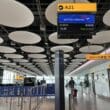


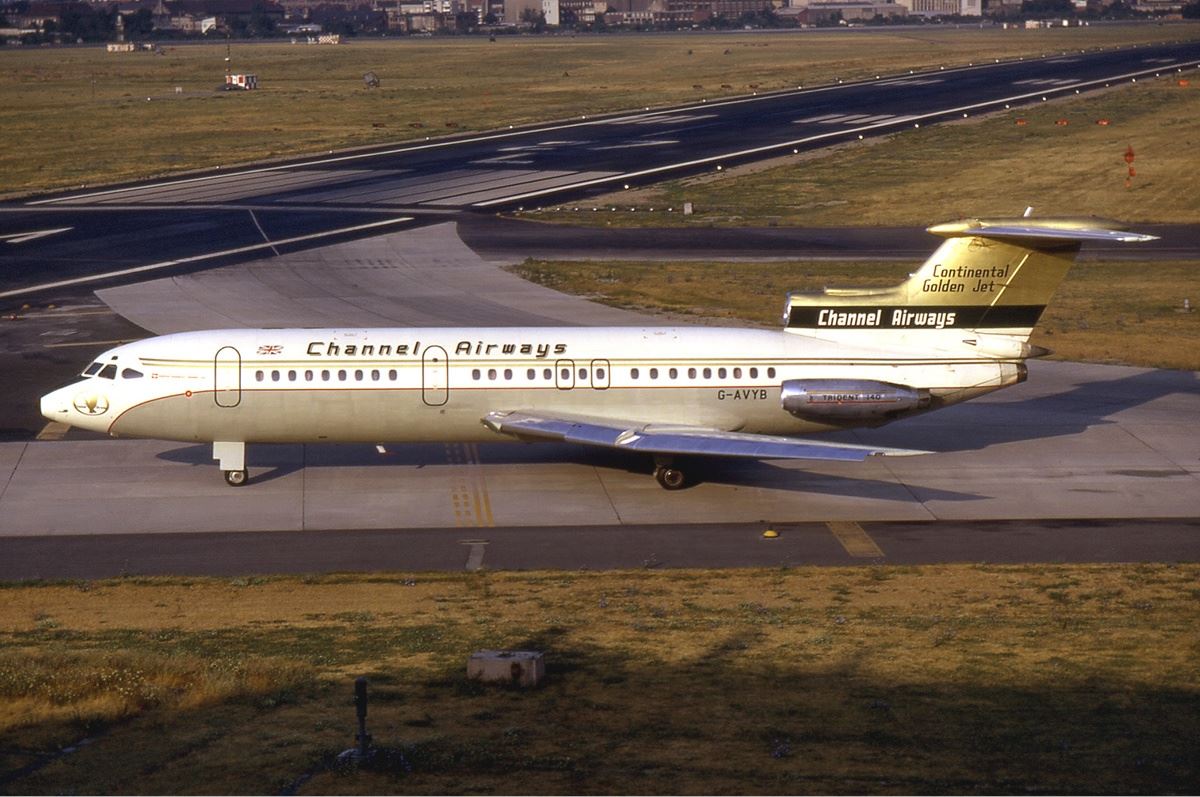
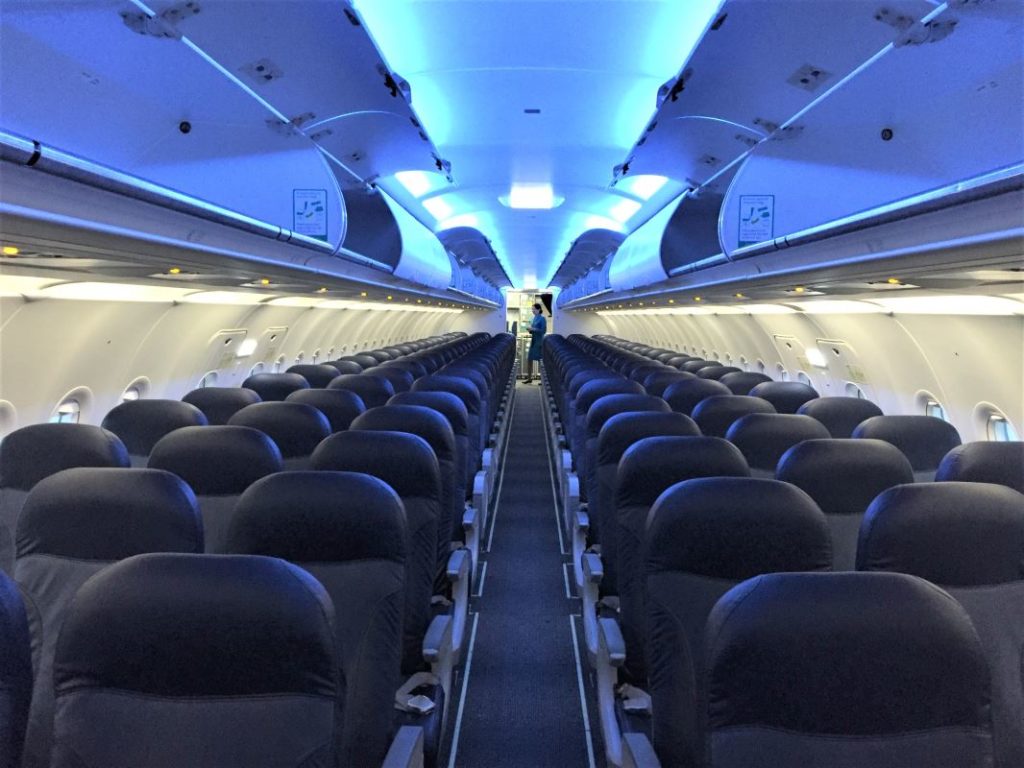


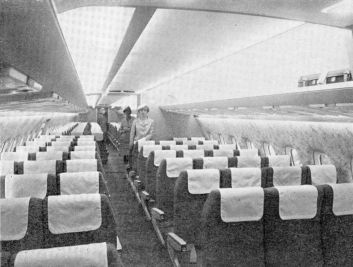


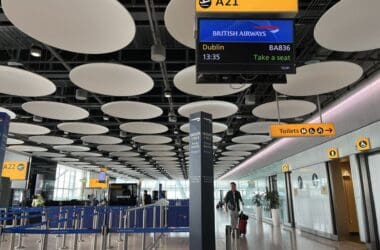
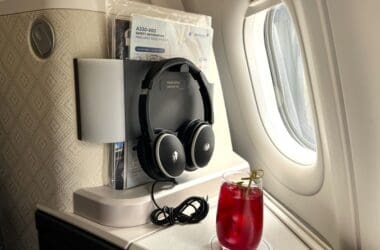
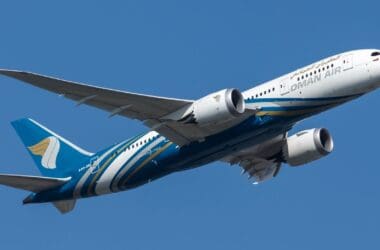
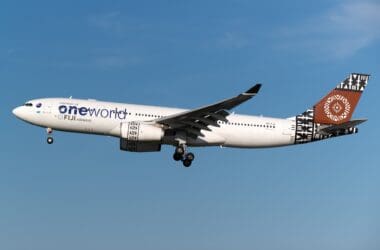
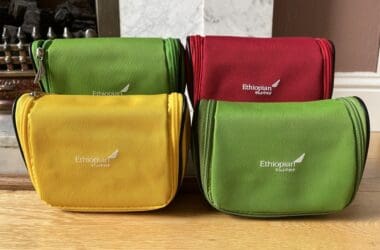
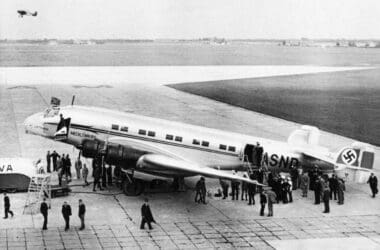
I believe that I have actually travelled on one of those Channel Airways tridents. In 1968. I was 8 years old and we flew from STN to PMI. My mum was excited because it was the first time she had flown on a jet. (She had flown several times before but never on a jet). However, I was too young to have any real recollection of the flight but I can imagine that those seats must have been very tight. We always seemed to sit at the back though so I have a feeling we were not in a block of 4 seats. I notice that the aircraft does not appear to be equipped for ‘seat back’ catering and I believe that Channel Airways provided a full complimentary meal service (to holiday charter flight standards, usually a cold salad, cheese and crackers, roll and butter, and desert with tea or coffee). All drinks, even soft drinks, were charged for on holiday charter flights but at genuine duty free prices which were cheaper than in a pub at home and the drinking culture of the era ensured a good level of bar sales. One tour operator which used Channel Airways used to offer ‘Champagne flights’. This was before the laws about use of the Champagne name were introduced so the free glass of champagne was in fact a plastic glass of the cheapest sparkling wine.
I can remember STN airport though. This was before they built a proper terminal and the passenger terminal was situated in large Nissen hut type structures.
It must be remembered that these aircraft would have been used only on holiday charter flights so Channel Airways would not themselves be making any extra money from the ultra high density seating as the aircraft would be chartered to the tour operator at a fixed rate irrespective of the number of passengers aboard a particular flight. It would have been profitable for the tour operator though.
Thanks for the comprehensive message here. It definitely helps to provide a lot more colour and context to the services that were operated back in this era. Stansted has certainly changed a lot since those days – no more Nissen huts. I did do an article on the seat back catering, but it was also quite difficult to find pictures of that as it seems to have been a really short-lived thing overall. Appreciate all the detail and enjoyed the read, so thank you again!
Yes there is not a great deal of information available about seat back catering or exactly which UK charter airlines offered it. I believe that it was limited to BAC-1-11 aircraft for some reason. We know that Court Line offered it and I also know that British Caledonian offered it on their dedicated charter BAC-1-11 fleet. At that time British Caledonian had 3 different interior configurations for the BAC-1-11’s. There was a high density configuration with seat back catering used on their holiday charter fights, a normal all Y configuration with a better seat pitch for the scheduled services and a small number of BAC-1-11’s in a two class FY (this was before C class existed) configuration with an 8 seat dedicated 2 X 2 F class cabin, the only UK carrier to offer F class on a BAC-1-11. The two class BAC1-11’s were used on that long flight to West Africa routed LGW-LIS-CMN-LPA-BJL–FNA.
I have never personally experienced seat-back catering so I can’t say exactly what the meals consisted of but I have travelled on an aircraft equipped for it when British Caledonian substituted a charter configuration BAC-1-11 on a scheduled LGW-JER flight which was of course too short for there to have been any meal service. The headrest of the seat, obviously thicker than the thin headrests of today, contained two horizontal slots, one above the other, with lockable doors into which the meals were placed, one for the outbound flight and one for the inbound flight. When it was time for the passengers to eat, a cabin crew member would pass through the aircraft with a key and unlock one of the slots.
It is difficult to be sure how long seat back catering lasted. My best guess would be from late 60’s to mid 70’s.
Thanks for all of that information. Maybe the specific seat type for the seat back catering was only certified on the 1-11 or something like that. There certainly isn’t much written about it, and it’s very much a fairly obscure piece of aviation history. Appreciate the detail there, I’m always happy to learn more!
I actually flew on that thing. STN-VCE. I was a tad smaller than I am now. I even sat in one of the 4 seaters along with some of my school colleagues – we were on a school trip. Always remember it.
I was hoping someone would have actually experienced it, as it really wasn’t in service all that long. Not a lot of people would have “enjoyed” that. I guess it would have been fine enough for school kids though! Do you remember anything else about it? Thanks for the comment!
Interesting. Also the paint job…Continental’s pre-1967 scheme. I looked it up, and it’s because Channel AIrlines bought Continental’s large Viscount fleet and didn’t want to repaint them, so it saved money by adopting Continental’s “golden tail” livery for all Its subsequent planes.
I noticed it was virtually the same as the old Continental colours. Great information there, that they bought the Continental Viscounts. Apparently Channel Airways were very good at saving and making money, by cramming in as many as they could – the other aircraft in their fleet were apparently also very dense. Looks like the focus on money included other areas too. Great catch, thanks for that!!
The DH Hatfield salesmen claims to have been the brains behind the 7 abreast monster. He later became the Bus salesman for AC and thats when I heard this story from him.
I wouldn’t at all be surprised about that, really. I’d love to see those seats in the flesh to really see what they’re like. Hard facts and figures like seat width would be interesting to see.
Thanks for the interesting story!
You’re welcome! Thanks for the kind words.
Cool history
Thanks a lot, glad you enjoyed it!